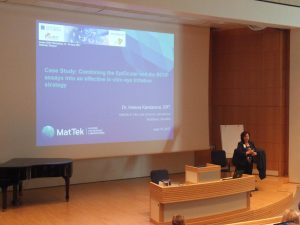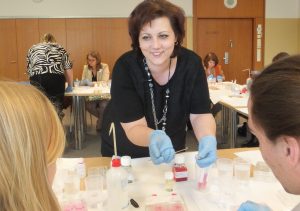

Representatives from MatTek IVLSL will run a technical workshop on the Assessment of Skin Irritation of Medical Device Extracts in vitro. The workshop will include a 20-minute talk on the strategy, followed by a 1-hour practical hands-on training session. The talk and training will be led by Dr. Helena Kandarova, Executive Director of MatTek IVLSL, and Dr. Silvia Letasiova, Senior Scientist and Production Manager of MatTek IVLSL. The presentation and talk will take place at the University of Tampere in Tampere, Finland, June 14-16.
MatTek IVLSL will also be presenting a lecture on EpiOcular and BCOP assays jointly used to create an effective in vitro eye irritation strategy:
Case Study: Combining the EpiOcular and the BCOP assays into an effective in vitro eye irritation strategy
Helena Kandarova, MatTek In Vitro Life Science Laboratories, Mlynské Nivy 73. 821 05 Bratislava, Slovak Republic
hkandarova@mattek.com
The Bovine Corneal Opacity and Permeability (BCOP) test was accepted by the regulatory bodies for the identification of corrosive and severe ocular irritants (Global Harmonized System [GHS] Category 1) already in 2009. The EpiOcular Eye Irritation Test (EIT) has been implemented into the OECD guidelines in 2015 as a method 492 for identification of chemicals nor requiring classification and labeling (GHS No Category).
The concept of the combined use of these two methods (top-down and bottom-up) has been already before investigated by BASF (1, 2). In addition, the combination of the BCOP and EpiOcular is recommended by Office of Pesticide Programs, U.S. Environmental Protection Agency (EPA) (3). Within the EPA prediction scheme, EpiOcular time-to-toxicity protocol (ET-50, Neat method) is being used to predict Toxicity Category I, III or IV of the Antimicrobial Cleaning Products (AMCPs).
The use of the EpiOcular EIT, ET-50 and BCOP methods alone and in combination has also been investigated in the Cefic funded CON4EI project. The objective of the CON4EI project was to develop tiered testing strategies for eye irritation assessment. A set of 80 reference chemicals was tested with eight different methods to enable their direct comparison, as well as, to develop an appropriate testing strategy based on the strengths and weaknesses of the tests.
The presentation will summarize the use of the BCOP and EpiOcular by the chemical, pesticides and antimicrobial cleaning products industry. It will discuss the advantages and limitations of the proposed BCOP-EpiOcular testing strategy.
1. Kolle, S.N., Kandarova, H., Wareing, B., van Ravenzwaay, B. & Landsiedel, R., 2011. In-house validation of the EpiOcular™ eye irritation test and its combination with the bovine corneal opacity and permeability test for the assessment of ocular irritation. ATLA 39, 365–387.
2. Kolle S.N., Moreno, M.C.R., Mayer, W., van Cott, A., van Ravenzwaay, B., et Landsiedel, R., 2015. The EpiOcular™ Eye Irritation Test is the Method of Choice for In Vitro Eye Irritation Testing of Agrochemical Formulations: Correlation Analysis of EpiOcular™ Eye Irritation Test and BCOP Test Data to UN GHS, US EPA and Brazil ANIVSA Classifications. ATLA 43, 1-18.3.
3. USE OF AN ALTERNATE TESTING FRAMEWORK FOR CLASSIFICATION OF EYE IRRITATION POTENTIAL OF EPA PESTICIDE PRODUCTS, 3-2-2015, Office of Pesticide Programs U.S. Environmental Protection Agency Washington DC, 20460. Available online: https://www.epa.gov/sites/default/files/2015-05/documents/eye_policy2015update.pdf


